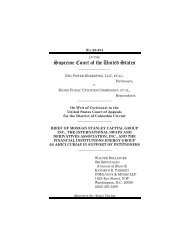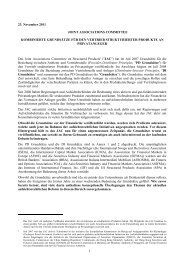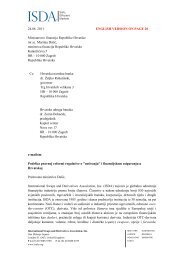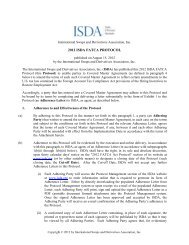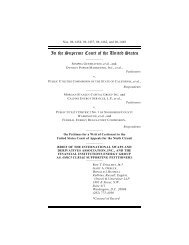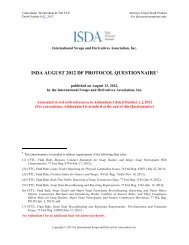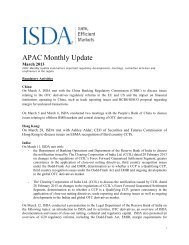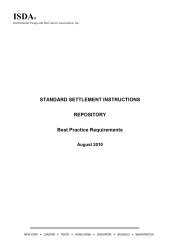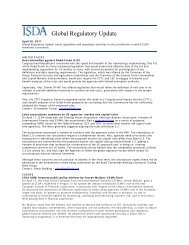ISDA Margin Survey 2013
ISDA Margin Survey 2013
ISDA Margin Survey 2013
You also want an ePaper? Increase the reach of your titles
YUMPU automatically turns print PDFs into web optimized ePapers that Google loves.
3. EXTENT OF COLLATERAL USE<br />
12<br />
3.1. NUMBER AND TYPES OF COLLATERAL AGREEMENTS (SUPPORTING NON-CLEARED OTC TRANSACTIONS)<br />
Respondents to the <strong>2013</strong> <strong>Margin</strong> <strong>Survey</strong> report 118,853 active 6 collateral agreements in place for non-cleared<br />
OTC transactions, compared with 137,869 in the 2012 <strong>Survey</strong>, a 14 percent decrease. There are a number of<br />
factors contributing to this reduction. These include counterparty consolidation whereby legacy collateral<br />
agreements are discontinued over time due to mergers, effort by firms to consolidate multiple agreement types<br />
for the same legal entity (where a credit support deed, annex and long form confirmation may, for example, be<br />
in place), the more prolific negotiation of CSAs to cover multiple entities, and a transition toward cleared<br />
transactions. As per table 2.1, there has been an increase in the reported collateral in circulation, and therefore<br />
it is unlikely that a reduction in active collateral agreements is reflective of reduced margining and collateral<br />
activity throughout the industry.<br />
Charts 3.1 and 3.2 show the split between unilateral and bilateral agreements and between <strong>ISDA</strong> CSA 7 and non-<br />
<strong>ISDA</strong> CSA agreements. Respondents report that approximately 77 percent of their <strong>ISDA</strong> CSAs and 88 percent of<br />
all agreements are bilateral. As in previous years, <strong>ISDA</strong> CSA documentation is the most frequent choice among<br />
practitioners at about 87 percent. Non-<strong>ISDA</strong> CSA documents include bespoke margin agreements, long-form<br />
confirmations with collateral terms, master margining agreements, commodity-specific margining agreements,<br />
and jurisdiction-specific agreements such as French AFB and German Rahmenvertrag.<br />
Chart 3.1: Percentage and types of collateral agreements used by respondents: Bilateral vs. Unilateral<br />
6 Active collateral agreements are those with outstanding exposure and / or collateral balances.<br />
7 For these purposes we include <strong>ISDA</strong> Credit Support Annexes according to New York, English and Japanese laws, <strong>ISDA</strong><br />
Credit Support Deeds, and <strong>ISDA</strong> <strong>Margin</strong> Provisions.<br />
<strong>ISDA</strong> <strong>Margin</strong> <strong>Survey</strong> <strong>2013</strong> June <strong>2013</strong>



